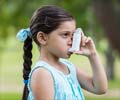Interaction between wheezing illness and certain genes early in life may lead to developing asthma by age six, according to a new study published in the New England Journal of Medicine.
Respiratory viral infections, especially human rhinovirus (HRV) account for approximately 80 percent of asthma triggers in children. And infants who have HRV infections with wheezing problems have an increased risk for developing asthma in childhood. But HRV does not always lead to wheezing illness in children, nor does wheezing illness cause asthma in all cases. Since asthma is also hereditary, genes probably have a big role to play.So, to find out how genes and wheezing illness caused by HRV or respiratory syncytial virus (RSV) in infancy are connected in the development of asthma in children, Minal Caliskan and colleagues at the Department of Human Genetics, University of Chicago, studied the data from two groups of children –
- 200 children from the Childhood Origins of Asthma (COAST) group who had at least one parent with asthma and /or respiratory allergies. The kids were followed from birth to age 6.
- 297 children from the Copenhagen Prospective Study on Asthma in Childhood (COPSAC) group who had mothers with asthma. These children were followed from birth to age 7.
In addition the investigation also included 100 unrelated adults.
The genes in question here are gene variants in the region of chromosome 17q21 which earlier studies found to be strongly and reproducibly associated with childhood onset asthma. The present study investigated the role of expression levels of two 17q21 genes, GSDMB ORMDL3.
- the risk for developing asthma was 5-fold in children with HRV and wheezing;
- the risk for developing asthma was 26-fold in children with both, HRV with wheezing and asthma genes;
- the overall prevalence of asthma was lower in the COPSAC cohort than in the COAST cohort, maybe because the rate HRV wheezing illness was lower in COPSAC group and also because the diagnosis of asthma required a response to a 3-month course of inhaled glucocorticoids followed by a relapse after treatment was stopped;
- wheezing caused by respiratory syncytial virus (RSV) did not show the same interaction;
“The combination of genetic predisposition and the child’s response to this infection has a huge effect,” said Carole Ober, co-author of the study.
Although scientists are not very clear on how the genes at the 17q21 locus lead to asthma, they suspect that ORMDL3 may play a role in viral respiratory infections. To investigate how exposure to HRV altered expression of the asthma genes 17q21, the researchers in this study collected blood samples from 100 adults and exposed the immune-system cells from the blood to HRV. As expected, ORMDL3 showed a huge response by more than doubling its presence in the exposed cells.
‘Over expression of ORMDL3 may increase the efficiency of the infection or viral replication in respiratory epithelial cells, which are the site of HRV infection and replication, and possibly reduce the ability of these cells to repair themselves after HRV infection,’ according to Minal Caliskan, the lead author of this study.
She concluded – ‘this study establishes a role of 17q21 variants in the development of HRV wheezing illnesses during early childhood and shows that the effects of the 17q21 genotype on the susceptibility to asthma are seen primarily in the subgroup of children who have had an HRV wheezing illness in early childhood’ and suggested further investigations into the’ joint effects of genetic and environmental risk factors’ to understand the mechanisms of complex diseases.
Reference: Çaliskan M et al. Rhinovirus wheezing illness and genetic risk of childhood-onset asthma. N Engl J Med 2013 Mar 27.
Source-Medindia













